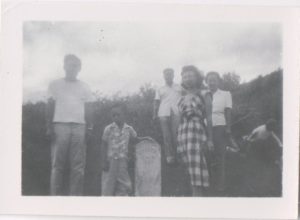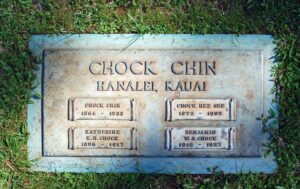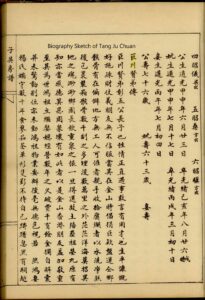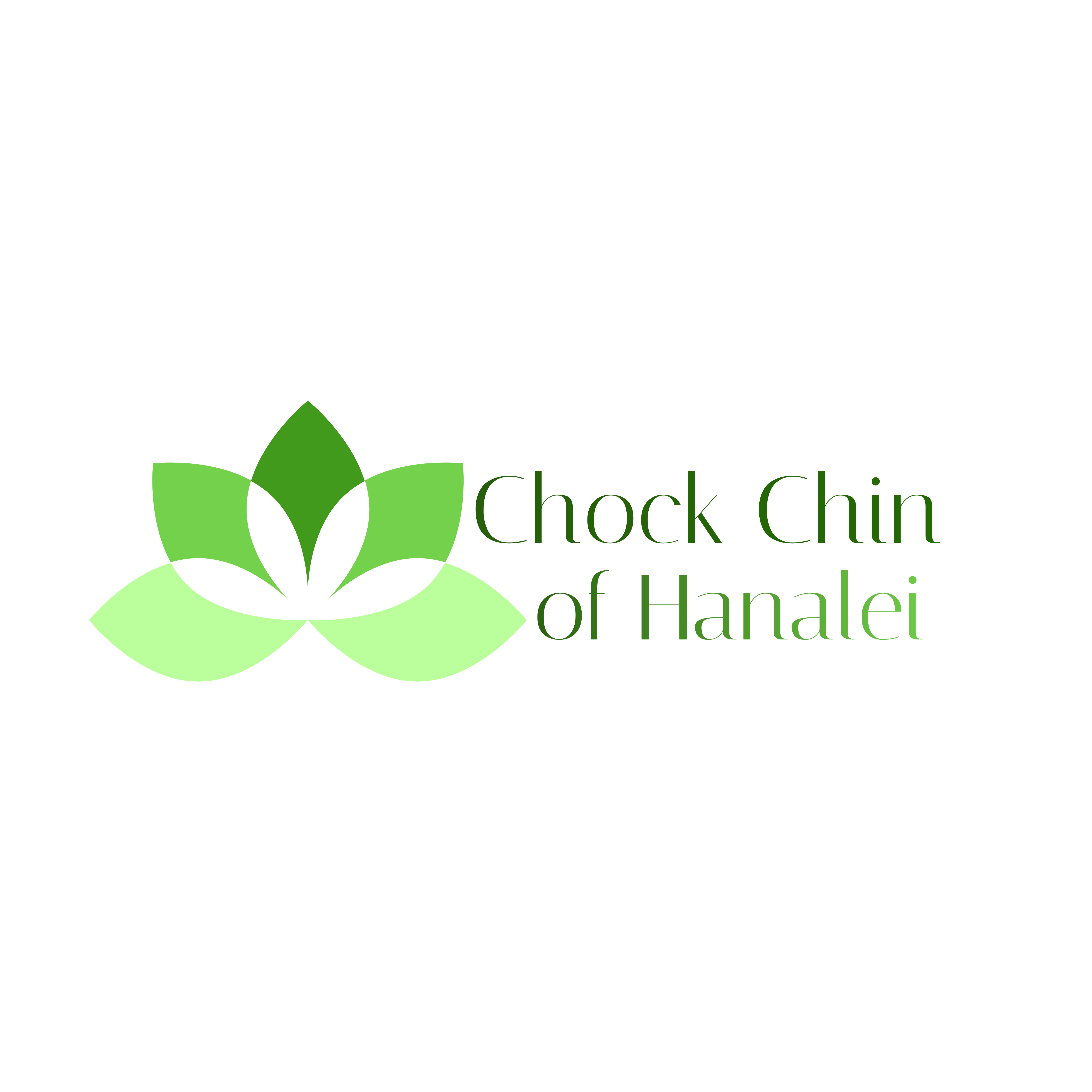Chinese Migration to America, historian Brian Dillon explained that only 10% of Chinese migrants to California who came in the 19th century to work on the railroad, search for gold, etc., can be found in California cemeteries. This is because Chinese who leave their hometowns and migrate to other countries usually want to be buried in their hometown. Many families arranged for their bodies to be shipped back to China after their death. Consequently, it is difficult to find Chinese headstones in California. (To learn more about the tradition of bone repatriation, visit the Tung Wah Coffin Home Archives. [English])

Original grave of Chock Chin in Hanalei Cemetery
By contrast, 90% of Chinese migrants who settled in Hawaii during this same period are actually buried in Hawaii. Chock Chin and his family were originally buried in the Hanalei Cemetery. Many years later, his widow, Chun Shee, moved to Honolulu in her later years, to be near her children who had also moved there as adults to raise their children and work in their professions. They would go back to Hanalei every year for Ching Ming.

Chock Chin final resting place – Honolulu
Eventually they decided it would be easier on the family if the bodies were moved to Honolulu (not sent back to China), so the family could visit and honor their graves more properly throughout the year. Chock Chin and his second Chinese wife Hee Shee (my grandmother) and the children who died in Hanalei were reinterred in the Nuuanu Memorial Park in Honolulu. Here is their gravestone.I believe the reason the Chinese in Hawaii were willing to be buried there, as opposed to the ones in California, may have a lot to do with the vast difference between the way those two cultures accepted them into the community. In California, they experienced great persecution. They were segregated — only allowed to live in specific areas of town, bullied and badgered by the populace without repercussion, prevented from getting good jobs, prevented from bringing their wives and families to join them, and even beaten and killed from time to time. Multiple laws were passed that effectively inhibited the Chinese from prospering in America. Eventually the United States passed the Chinese Exclusion Act in 1882. According to history.com:
The Chinese Exclusion Act of 1882 was the first significant law restricting immigration into the United States. Many Americans on the West Coast attributed declining wages and economic ills to Chinese workers. Although the Chinese composed only .002 percent of the nation’s population, Congress passed the exclusion act to placate worker demands and assuage prevalent concerns about maintaining white “racial purity.”
Louise discovered a wonderful story about how wealthy Chinese in China actually helped some of these California Chinese expats to have their bodies returned to China. She wrote:

The biography of Tang Ju Chuan in the Tang/Tong唐 jiapu.
Recently when I was working on your Tang/Tong唐 Jiapu, I came across an article about a Tang ancestor named Tang Ju Chuan唐巨川 who was born in 1824. He was a successful businessman in Shanghai and was very generous to his friends.
He once stayed in San Francisco, and saw that many Chinese died in a foreign country. He decided to donate lots of money to help send the deceased back to their hometown. For the Chinese it was, and is, important to be buried in their hometown. We call this “Falling leaves return to their roots”. He helped thousands of them return back to China.
The most touching part of this story is that if the bodies were buried in a remote area and no workers were willing to go to pick them up, he would go there by himself and clean the decomposed bodies himself before he put them in the wooden boxes and shipped them to their relatives in China. Because of his act of kindness, he was respected by many in the San Francisco Bay area.
The Chinese experience in Hawaii was a very different story. When my grandfather emigrated, Hawaii was still an independent kingdom, with a king who was very happy to have them bring their expertise to the sugar plantations and other developing industries in the islands. When the Chinese settled in the Kingdom of Hawaii they were welcomed, easily integrated into communities, created large families, started businesses, and contributed tremendously to the growth and success of the areas where they settled.
You can see the effects of this in Chock Chin’s family — their prosperity allowed them to raise a huge family, send them to college, and launch them into medical, engineering, and educational professions that continue to bless the lives of thousands. Similar patterns are found in the lives of the other Guan Tang Zhuo migrants who settled on different islands of Hawaii and went on to raise educated, hard-working, and successful children.
Later, when Hawaii became a territory of the USA, some of the US prejudices began to affect the lives of the Chinese. And when they became a state, this became more pronounced.
A Time Magazine article posted in 2015 reviews the immigration history of Chinese coming to America, and speculates about how the Chinese may experience a resurgence of ethnic bigotry against them as America’s attitudes about China shift.
Once singled out for exclusion by law from the U.S., Chinese immigrants now make up the largest single group of arrivals a year into this country. The Census Bureau says China replaced Mexico as the top country of origin for immigrants to the U.S. in 2013.
Given the history, this growth—and the fact that Chinese immigrants are considered part of the Asian-American “model minority”—seems improbable. But the story of Chinese immigration, past and present reminds how fickle our attitudes about immigrants can prove.
Sadly, we are seeing the “fickle” attitudes about Chinese Americans shifting already. The global Covid-19 pandemic, which began in Wuhan, has led to overt and covert violence against Asians in different states in 2021. Here’s an excellent article from March 2021 that explains this trend, and offers science-based ways to counter it.
Why Are Asian Americans Being Attacked and What Can You Do About It?
Here are science-backed ways we can reduce hatred and division.
